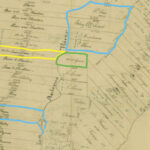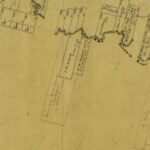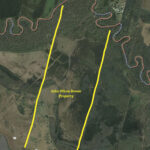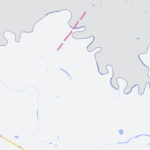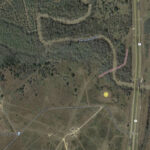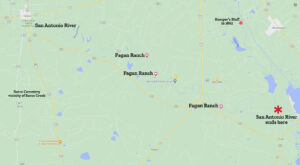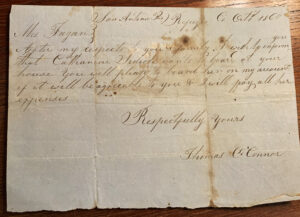Bill:
Click to get a
>> working map <<
for us to mark the spots of our quests and finds.
Carlos Crossing
GLO map from 1851 showing John White Bower’s land (excerpt marked below). See notes in red to show Jose & Juan De La Garza grant, as well as M. Reily and Mary Byrnes grants down river. Original Fagan grants were adjacent to M. Reily’s. John Williams grant on the opposite side of the river will place Sideck grants (which became Fagan ranches later).
John White Bower. 7 December 1808, Talbotton, Talbot Couty, GA – 13 January 1850, Refugio County, Texas. Burial in Bower Cemetery in Refugio County. Notation from FindAGrave says that he was “buried near the ferry he operated before the revolution”. And further that he began operating a ferry on the San Antonio River on the far bank of the Carlos Rancho in mid 1835.
John White Bower’s Grave. Article on his life from TSHA: “In 1838 Bower married Bridget O’Brien. Their daughter Frances Elizabeth married James Power, Jr., son of the empresario James Power. Bower represented Refugio County in the House of the Sixth and Seventh congresses of the Republic of Texas, 1841–43, and was elected chief justice (i.e., county judge) of Refugio County on October 4, 1843, and again in 1847. He died on January 13, 1850, and was buried near the San Antonio River ferry he had operated years before.” No coordinates given for the cemetery.
I have heard more than one source (including a prominent local historian) generalize that the ferry was “right about where Hwy 77 crosses the river. It does not seem right, given the information about John Bower, the location of his property across the river from the Carlos Rancho (several miles upstream from the Hwy 77 bridge). But I have noticed that there’s a clearing of sorts that looks like it could have been an old crossing — just west of the bridge. See map below. And someone (Hardin, I think) told me that there’s a historic marker in the field where I have marked the yellow ‘star’. I have not seen that marker. If you feel like trespassing …
- Future Reference: Tenneco Survey
- See high res scan of the Carlos Ferry photograph.
The Mystery of Camp Sarco/Larco
Or Larco Creek? Larco is not a translatable word in Spanish. It appears to be a proper name with roots in Peru, also Italy (Larko) and France (Larrocque). There is a Larco Way street in a San Antonio subdivision, but the other streets in that subdivision are not named in any obvious theme.
The Sarco Creek Ranch is located near Goliad. Established in 1871 by Thomas M. O’Connor. Now a working ranch breeding quarter horses for ranch work and competitive events. They have an up-to-date Facebook page.
Appears there may have been a small community at Sarco? Or maybe this was just the ranch headquarters? Large cemetery with no familiar names and smaller McQuill (or is it McGuill?) family cemetery possibly abandoned in the woods. McQuill road nearby. There are McGuills in the Refugio area today.
- Map from 1840 on GLO. Sarco Creek at the top.
- Map of Texas 1852 showing Sarco Creek marked with * in the center. See original map online. Also notes roads marked on this map. For future discussion.
Regarding Fagan lands shown on the maps above:
The original Nicholas Fagan grant (also John and James’) was downriver from Don Carlos Rancho. The John Williams grant was willed to John Fagan in 1837; it would be Elen Fox Fagan’s ranch after 1860. The Anthony Sideck grant would have been Catherine Fagan Sideck’s ranch after 1850.
From Official Records War of the Rebellion
The commanding general directs me to inform you that Brigadier- General Bee with his forces has been ordered to Victoria. For fear he may not have received the orders, you will please send him an order from the general commanding to Larco Creek, west, and low down on the San Antonio River, to proceed to your support with the utmost rapidity.
From the best information received at these headquarters, the enemy does not number more than 3,000 men, but should his forces be as large as you have reported, or should the fort become untenable for any other reason, you will withdraw your garrison, guns, and stores at the first opportuuity, commencing at early dusk, spiking your heavy cannon, and destroying what you cannot move, and take post at Victoria, securing the rolling-stock and destroying the road, and informing General Bee, if not with you, of the result, requesting him at the same time to join you there.
Should you be forced to fall back from Victoria, retreat toward Columbus, keeping in observation of the enemy. Report fully and frequently to these headquarters.
By order of Major-General Magruder :
EDMUND P. TUENER,
Assistant Adjutant- Oeneral.
Go to Reference
“You will proceed with your whole force and all you can collect to Victoria by forced marches, and inform your men and the country through which you pass that it is not the intention of the commanding general to give up the country west of the Colorado, but, on the contrary, to defend the whole of it, if it be possible. This communication will be sent to you both at Larco Creek and Corpus Christi.”
From Texas in the Confederacy/Winsor, p. 22
Camp Kemper’s Bluff (Victoria)
Located on the west bank of the Guadalupe River approximately 10 miles southwest of Victoria. Brigadier General Hamilton P. Bee selected this bluff as a campsite because it was accessible to the coast and San Antonio. Bee and his command were quartered in this encampment in November and December 1863. Major General Magruder repeatedly reprimanded Bee for selecting such a remote campsite and another site was selected on the San Antonio River bottom near Fagan’s. (O.R. Army, Ser. I, Vol. 26, Part II, pp. 436-37.)
Kemper’s Bluff (see TSHA) on the Guadalupe. General Store in 1862. See this map for location of Kemper’s Bluff. Also see map below for location in relation to Fagan ranches in 1862.
Kemper City. 1864 Topographical Map of the Country between the San Antonio and Colorado Rivers. Shows the “island” created in the San Antonio River which is right at the Nicholas Fagan Rancho. Above it on the Guadalupe is marked Kemper City. Area seems to be really out of scale.
From Texas in the Confederacy/Winsor, p. 23
Camp Larco Creek (Refugio)
Located “west and low down on the San Antonio River”. This post was established by Brigadier General Bee as he retreated away from the advancing Union troops in December 1863. The campsite is presumed to be the post referred to as “Camp Fagan”. Bee moved his troops and wagons several times during November and December 1863 and many dispatches are signed “Fagans'”. (O.R. Army, Ser. 1, Vol 26, part II, pp. 444-445, 447.)
A Dog with a Bone
I just don’t get this. Larco Creek “low down on the San Antonio” and connecting it with Fagans. Sarco Creek itself does not run into the SA River. It is fairly far downriver if you consider the river’s starting point. Sarco Creek does appear on early maps of Texas and I cannot find Larco. But there are several references to “Larco Creek” in the OR papers. Note that they are all by the same writer, so it’s possible that he was simply consistent in his mistake. But consistently linking Camp Larco Creek and the Fagans is a mystery. While there were large Fagan ranches in this area, they were mostly owned and run by widows.
Fagan Family as of November-December 1863
Male issues of Nicholas Fagan and Catherine Hanselman-Balsch:
James Christopher Fagan age 37 if he was still alive; last noted on 1860 census at the Mission of Refugio.
William Nicholas Fagan age 35 if he was still alive; last noted on 1860 census at the Mission of Refugio.
Joseph Fagan (wagonmaker) died of measles at Arkansas Post in 1862.
Thomas Fagan age 24. (Married Angelle Curbelo from Refugio and moved to Liberty, TX after war.)
Peter Henry Fagan age 20. Enlisted July 1861- 7th Texas Mounted Volunteers (7th Cavalry). For some reason, Pete is the heir to the Nicholas Fagan Ranch, and not Thomas.
Fagan Bridge
This bridge was on the Ellen Fox Fagan ranch and allowed them to cross the river as a shortcut into Goliad (where Ellen went to church at La Bahia). This is a link to the Fagan Cemetery marker, now on cousin Joe Keefe’s property. Part of the original Sideck/Williams grants.
Ellen Fox was married to John Fagan, son of Nicholas. Their son, Peter Henry Fagan “Jr”, was my ancestor. He married Texana Clark. Their daughter was Lucy Fagan — the same Lucy Fagan who was present at the birth of Hallie Mae. Note that there are two Peter Fagans. Because of the confusion, my gg grandfather began to call himself “Jr”, even though he was a nephew of the other Peter Fagan. My kin is not the one buried in the mausoleum at the original Nicholas Fagan Ranch.
Photo of this bridge will be forthcoming.
Resources
A collection of links to various Internet sources.
- Texas Coastal Bend Collection
(discussing the collection’s website) (reference to the collection)
Louise’s site has gone offline. All of the links pointing to it go to a domain landing page. This site had photos taken at Carlos Crossing (the ferry) and also Fagan’s Bridge across the San Antonio River. Q. Why did she take down this website? Who has the database? What would it take to get this resurrected?
From the Fagan Papers
October 1860
Note from Thomas O’Connor (1817 – 1887) to my ggg grandmother, Ellen Fox Fagan (1826 – 1903) at her ranch just across the river from his. He’s asking her to board Catherine Sideck. This would likely be Catherine Louisa Fagan (1825 – 1900) who married Anthony Sideck about 1841. He died in 1850, leaving her with at least 5 children, the youngest of whom would be 11 years old at the time of this note. Not sure where the children are.

